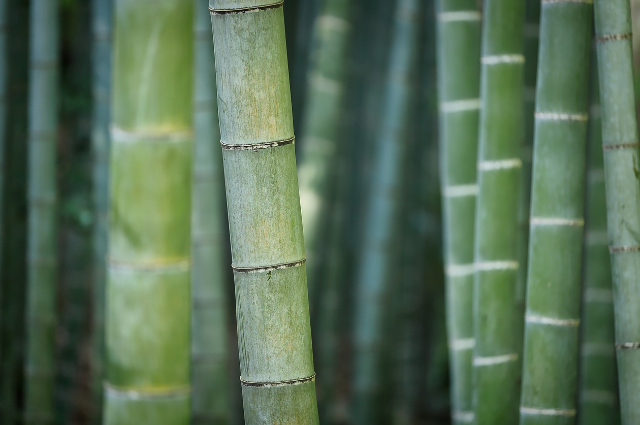
Image by Albrecht Fietz from Pixabay
Madhya Pradesh has emerged as the top state in India for bamboo resources by holding the largest bamboo-bearing area in the country. According to the “Indian Forest Survey Report (IFSR) 2021”, Madhya Pradesh claims a bamboo-bearing area of 1.84 million hectares which is a significant portion of the 15 million hectares of bamboo-bearing land across India. This success reflects the state's commitment to bamboo cultivation and its efforts to boost the sector.
Bamboo Coverage Across the Nation
The report highlights that Madhya Pradesh leads all other states in bamboo-bearing areas with 18,394 square kilometres of land covered by bamboo. Following closely are Arunachal Pradesh with 15,739 sq km, Maharashtra with 13,526 sq km and Odisha with 11,199 sq km. Across the entire country, the total bamboo-bearing area is approximately 1,49,443 sq kilometers.
Not only does Madhya Pradesh have the most bamboo resources, but it also leads in various categories related to bamboo density and regeneration. The state’s pure bamboo area covers 847 sq km, while dense bamboo areas span 4,046 sq km and thin bamboo regions occupy 8,327 sq km. Additionally, the state has the largest regeneration area by covering 3,245 sq km, showing a strong focus on sustainable bamboo cultivation.
The Role of the Bamboo Mission Scheme
One of the driving factors behind this growth is the state’s active participation in the ‘Bamboo Mission Scheme’. The scheme aims to encourage bamboo cultivation while simultaneously creating opportunities for industries centred around bamboo-based products. By promoting these industries, the state is generating employment and stimulating economic growth. Advanced techniques and technologies have been introduced to enhance bamboo farming by making the state a leader in the adoption of modern agricultural practices.
Infrastructure Development and Agricultural Impact
In addition to the focus on bamboo-based industries, the necessary infrastructure is being developed to support these businesses. Bamboo plantations have been established on 25,090 hectares of agricultural land in Madhya Pradesh. Through the Bamboo Mission Scheme, farmers are encouraged to grow bamboo on their land with the government offering financial assistance. Over the past five years, the state has supported 14,670 farmers by providing a grant of Rs 120 per plant, distributed over three years in a ratio of 50:30:20.
This initiative is making a noticeable difference in the lives of farmers as bamboo cultivation is becoming a viable source of income. The state government’s involvement in promoting bamboo plantations has not only helped increase farmers' earnings but also contributed to environmental protection and sustainable vegetation growth.
Financial Support for Private Sector Initiatives
To further enhance the growth of bamboo resources, the state government has extended financial incentives to the private sector as well. A subsidy ranging from 25% to 50% is available for individuals or organizations wishing to engage in bamboo plantations. This added financial support is aimed at boosting private sector participation and further expanding the state’s bamboo resources.
Madhya Pradesh’s leadership in bamboo cultivation is a testament to its comprehensive approach towards sustainable agriculture and economic development. With robust government initiatives like the Bamboo Mission Scheme and a focus on modern cultivation techniques, the state is setting a strong example for others to follow. As bamboo-based industries continue to develop, the potential for increased employment and environmental benefits makes Madhya Pradesh a model for the rest of the country.
Remarkable World of Bamboos
Bamboos are one of the most diverse and interesting groups of plants, belonging to the sub-family Bambusoidae within the larger grass family Poaceae also known as Gramineae. Unlike many other plants, bamboos is perennial, meaning it lives for several years and grows incredibly fast. These plants thrive in various regions across the globe, particularly in tropical, sub-tropical, and mild temperate areas. The distribution of bamboo species in different regions is largely determined by key environmental factors such as rainfall, temperature, altitude, and soil quality. In fact, natural bamboo forests are often found in tropical areas of Asia, especially between 15° and 25° North latitudes. In India, bamboo grows abundantly although it is not naturally present in the Kashmir region.
Bamboo Species: Global and Indian Perspectives
According to a report by the Food and Agriculture Organization (FAO) in 2007, there are about 1,200 different species of bamboo spread across 90 genera worldwide. India is home to about 125 native bamboo species and 11 species that were introduced from other regions, spread across 23 genera. The North-Eastern region of India along with parts of Northern and Southern India, are particularly rich in bamboo species. The dense deciduous and semi-evergreen forests of these areas provide ideal conditions for bamboo growth. The North-Eastern states along with West Bengal contain more than half of India’s bamboo resources. Other regions with significant bamboo populations include the Andaman & Nicobar Islands, Chhattisgarh, Madhya Pradesh and the Western Ghats.
Major Bamboo Genera in India
India is home to several important bamboo genera including Arundinaria, Bambusa, Chimanobambusa, Dendrocalamus, Dinochola, and Gigontochloa. These genera are found across different regions of the country, depending on the local climate and soil conditions. For instance, species like Bombusa and Dendrocalamus thrive in tropical environments, while Arundinaria is typically found in temperate regions, particularly at high altitudes in the Western and Eastern Himalayas. On the other hand, Phyllostachys prefers temperate to warm temperate conditions. In terms of forest ecosystems, Dendrocalamus strictus is often found in dry deciduous forests, while Bambusa bambos is more suited to moist deciduous forests. Meanwhile, the Gigantochloa rostrata the species is the most prominent bamboo in the semi-evergreen forests of the Andaman Islands.
Bamboo's Economic and Ecological Importance
Bamboo is not only ecologically valuable but also holds significant commercial importance, especially in Eastern and North-Eastern India. Some of the economically vital bamboo species in these regions include ‘Bambusa tulda’, ‘Dendrocalamus hamiltonii’, and ‘Melocanna baccifera’. These species are widely used in construction, furniture making and as raw materials for various industries by adding substantial value to local economies.
. . .
References:
